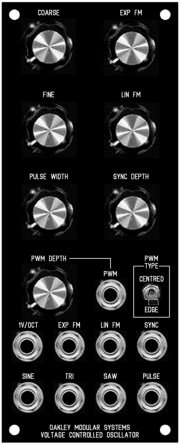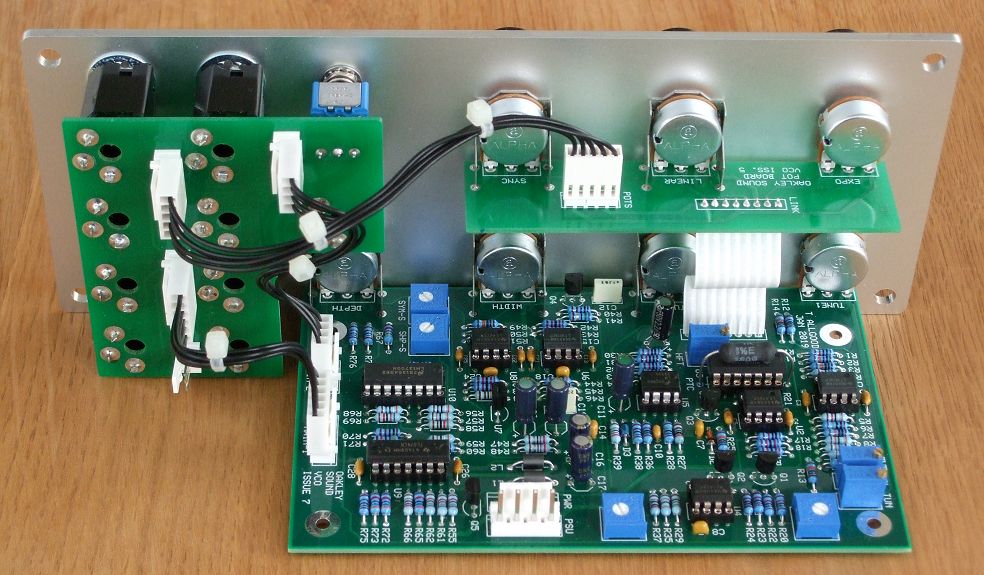
PCBs for this module are now discontinued

An excellent sounding and popular VCO (voltage controlled oscillator) module. The design was originally inspired by the classic sound of the Mini's VCOs with the central core of the oscillator being somewhat similar. However, a great many things have been added and changed to make it more suitable for a modern modular system.
Four output waveforms are provided simultaneously; falling ramp sawtooth, triangle, pulse and sinewave. Output levels are 10V peak to peak, in common with most modular systems.
Apart from the usual fixed 1V/octave modulation input, a fully variable exponential input is available as well as a fully variable linear modulation input.
Slave synchronisation is easily obtained by inserting a falling sawtooth waveform into the SYNC input. This input is level sensitive to allow different strengths of synchronisation. A front panel pot is provided to control the depth of the effect.
The pulse waveform can be modulated in two ways. You can have either 'centred' or 'edge' modulation styles selected by a front panel switch. The former will allow modulation of both edges of the pulse output, while the latter modulates only one edge. There is a useful and interesting difference between the two settings when used with a rapidly changing modulation signal like that from a fast LFO or an audio rate VCO.
The pulse output also features a useful method of maintaining average output level. This means that fast sweeps of pulse width no longer produce any audible clicks as they do on other VCOs you may have used.
Power (+/-15V) is provided to the board either by our standard Oakley 4-way header or Synthesizers.com header. Current consumption is approximately 35mA per rail.

The Oakley VCO in a natural finish 2U panel showing an issue 7 main board with issue 5 socket and pot boards. All pots are 16mm Alpha/Alps types
The PCB
The main board size is 89 mm (deep) x 143 mm (high). The issue 7 board is a four layer design with through plated holes, has tough solder mask both sides, and has bold component legending for ease of construction.
The VCO module features uses a three PCB set. Each PCB can be puchased individually. The three board method allows all the wiring to be done with a special socket PCB, special pot board PCB and 0.1" flexible connections. The VCO electronics are housed on the main board. The interconnection between the main board and pot board is via a 8-way preformed jumper interconnect. If you are building this module this system will reduce assembly time by at least an hour and a half!
Some people will wish to use this Oakley design in a non standard format, such as fitting it to another manufacturer's rack or one of their own invention. This is perfectly easy to do. Simply do not purchase the socket board or pot board and wire the main board to the sockets as per usual.
Sound Sample Downloads
Some MP3 samples of the Oakley VCO in action. The VCO was controlled by a midiDAC-2. Its output was fed into an Oakley ADSR/VCA and then onto the desk for recording. Only one VCO output is being heard, although for the sync'd samples, another VCO was required to provide the master frequency.
Sinewave output. Short sequence with light reverb
Pulse output. Same short sequence with EG sweeping the pulse width.
Pulse output, manually swept from 10% to 90%. Short sequence with light echo.
Sawtooth output. The VCO you are listening to is synchronised to a second VCO via its 'sync' input at a fixed frequency. The first VCO is now a slave VCO. The coarse frequency pot of this slave VCO is swept manually up and then down.
Pulse output and modulating with a VC-LFO. There are eight samples in this set. The first pair of samples have the pulse width modulated by an sine wave LFO at a slow speed and differ only by the position of the PWM type switch.
The first sound heard in the first pair uses the 'edge' setting, while the second sound uses the 'centred' setting. Unlike the 'edge' setting, the 'centred' setting does not introduce a varying phase shift which means there is no perception of frequency modulation. As we can hear, the perceived pitch shift in 'edge' mode is not that obvious at these lower modulation frequencies.
The second pair of sounds is the same sound but with a faster modulating frequency. Again, 'edge' is first and then 'centred' and this time the difference is more pronounced. The third pair of sounds is the same patch but at an even higher modulation frequency. The difference is now very obvious. The fourth sample is the previous patch but the switch is moved between 'edge' and 'centred' repeatedly. The fifth sample uses a triangle audio rate modulation from a slightly detuned VCO. Again, the switch is moved between the two settings to highlight to the difference in the sounds.
Project Downloads
Construction Guide Our handy guide to building Oakley DIY projects
Parts Guide Our handy guide to buying parts for Oakley DIY projects
Links to schematics are available to purchasers of the PCB or module and will be sent via e-mail when the board(s) are shipped.
Front Panel database
A Schaeffer front panel can be made for this module. The databases can be found by downloading the following links:
5U format in traditional black
To read, edit and print these files you will need a copy of 'Frontplatten Designer' from Schaeffer. Panels can be ordered via the program using its secure online ordering system.
Schaeffer are based in Berlin, Germany and can send panels to anywhere in the world. Delivery to the UK normally takes around ten days. For North American users you can also order your Schaeffer panels from Front Panel Express.
Back home